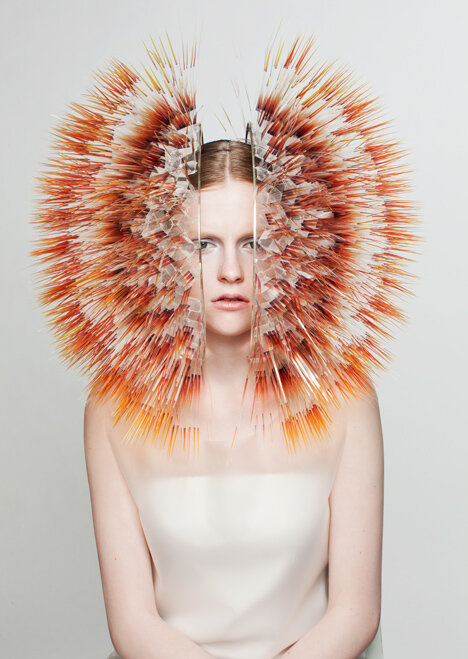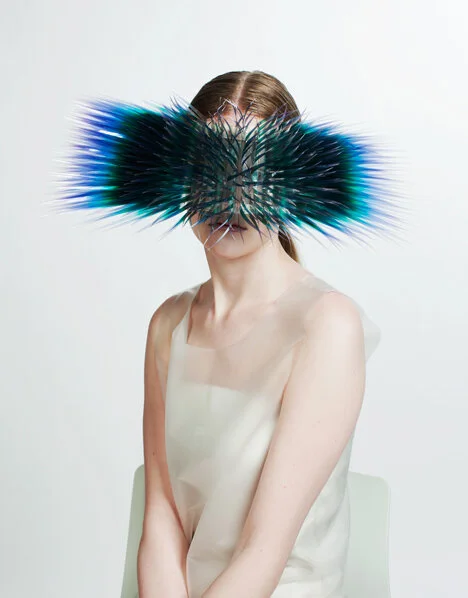Reading the Aura of Maiko Takeda’s Atmospheric Reentry Collection
by Emily Males
I came across a piece from Maiko Takeda’s Atmospheric Reentry collection during my daily Pinterest scroll. Her structure enveloped the model’s head and upper body, the tinted plastic spikes constructing the illusion of an aura. The rest of her collection replicates this effect, but many pieces take on different forms, covering the eyes, the torso, or the entire face. I became immediately enchanted by Takeda’s exploration of the esoteric study of auras and human energy fields and how she translates this ephemeral phenomenon into a tangible accessory visible to all.
Takeda began her career in fashion at Central Saint Martins College, studying jewellery design, and continued to The Royal College of Art, specialising in millinery. Atmospheric Reentry acted as her graduate collection for RCA and gained her international acclaim in the fashion world, soon being featured in shows in New York, Paris, Florence, Tokyo, and Basel, and publications such as Harper’s Bazaar, Cosmopolitan, and Elle. The adornments are a wondrous assemblage of hundreds of transparent spikes tinted with colour gradients at the tips, held in place by sections of acrylic and small metal rings. Such a process allows the structures to remain flexible and echo the movement of the wearer, transmuting through processes of motion, light, and time, creating a luminous effect. This glowing, fluid nature of Takeda’s pieces is what reminds me of the human aura: the pieces’ ability to blur the boundaries of their surrounding environments similar to an aura’s reflection of combined human and paranormal forces.
It is unknown whether the performative and documentative aspect of Atmospheric Reentry was intentionally made to mimic the attributes of corresponding aura colours; however, there seems to be too many instances of overlap for it to be accidental. Seen in the official photographs of the collection, the colours, their placements on the body, and even body language are consistent with aura characteristics. The model wearing a piece consisting of two domes covered in orange and red spines stares directly back at us; orange auras are related to a strength of sociability connected to the energy centre for exchange and relationships, while red auras represent a connection to our physical body and the tangible world around us. Her direct confrontation of the viewer obviously echoes these sentiments.
One of the headpieces is fabricated by a heavy cluster of indigo blue spines, twisting around the face and obscuring the eyes. Indigo is the colour of the third eye chakra, an obvious connection to the chosen placement of the piece covering the eyes. Another piece emanates pink spines in a halo like fashion from a model’s head. She looks up wistfully, longingly, seemingly daydreaming about something or someone. It should not come as a surprise this performance of Takeda’s headpiece once again follows translations of aura colours — those who radiate pink auras are deeply sensitive and embrace the ideals of romantic love. A final connection can be seen in the green headdress that covers the model’s entire face and upper body. The model turns away from us, holding her hands behind her back in a seemingly slouched posture. This body language and positioning illustrates feelings associated with a dark or murky green that radiates from those who feel victimised and criticised.
The supposed inspiration for Atmospheric Reentry came from Philip Glass and Robert Wilson’s opera Einstein on the Beach, of which Takeda said that “its futuristic mood of the space age heavily influenced the aesthetic of [her] collection.” While this connection might make analyses of the forms more clear - echoing shapes of helmets, spacesuits, and futuristic shield sunglasses - I find this connection to be rather paradoxical. The mundane materials and delicate structures heavily contrast the complexity of futuristic machinery. The hopes to create a “visual effect of an intangible aura,” previous illustrations of which have been noted as pseudoscience, also seems incongruous to a strong emphasis on science and technology. Yet, somehow, Takeda is able to unite these polar opposite concepts in a way that is incredibly beautiful. Her harmonious combination of the paranormal and the scientific is arguably what makes her work so fascinating. What will be increasingly intriguing to see is how technology’s growing influence, especially in the world of fashion, will inform the ephemeral nature of Maiko Takeda’s works.
ST.ART does not own the rights to any images used in this article





